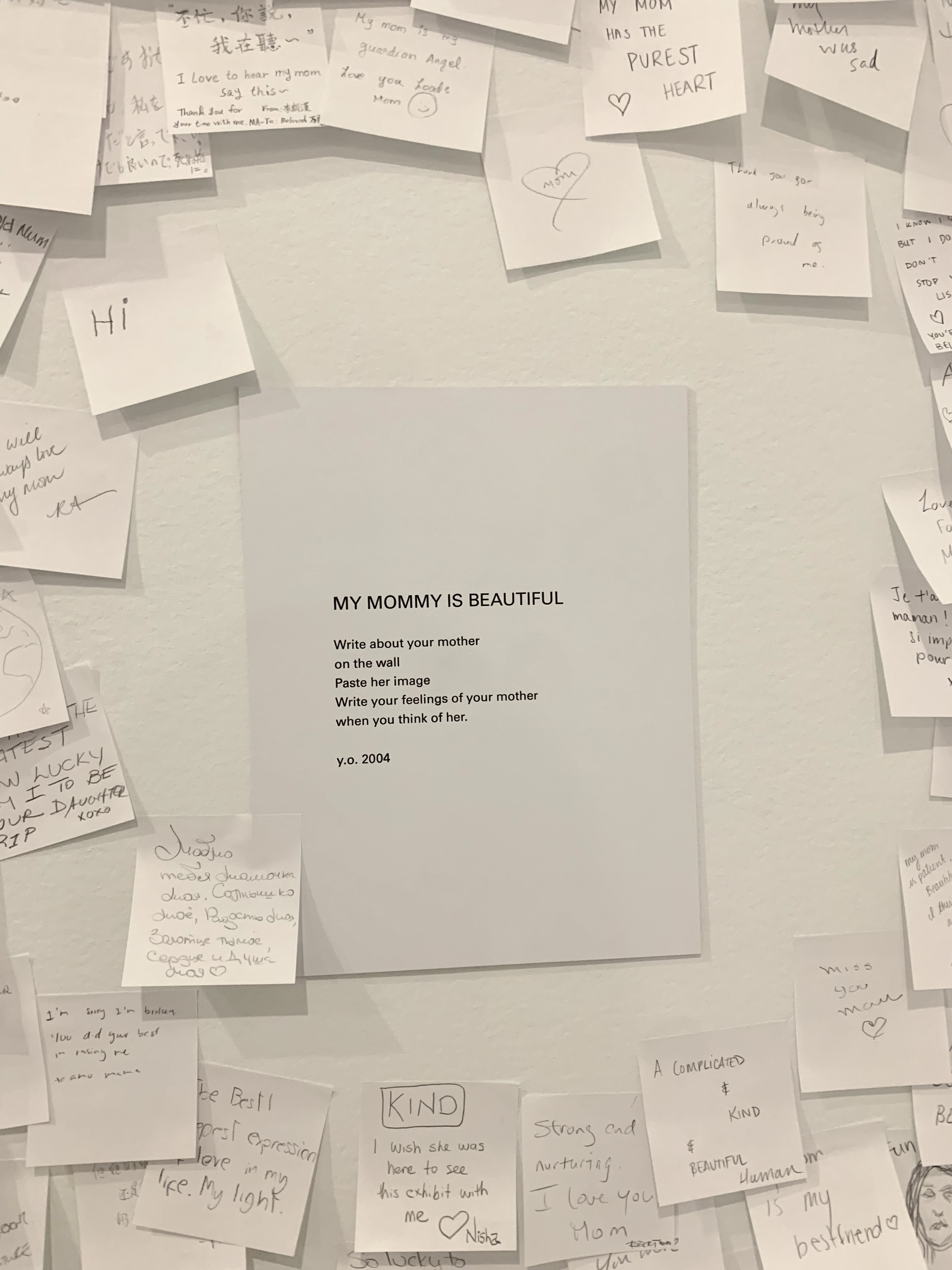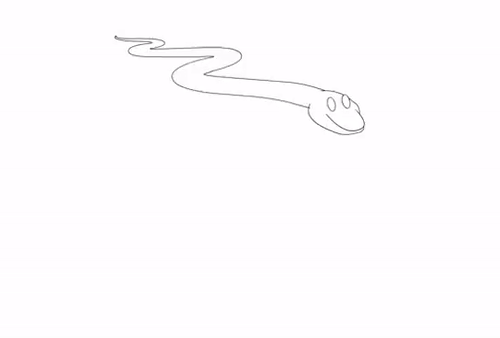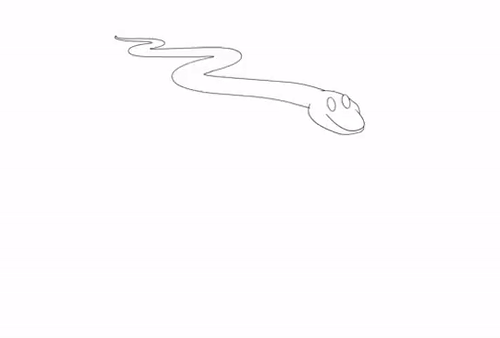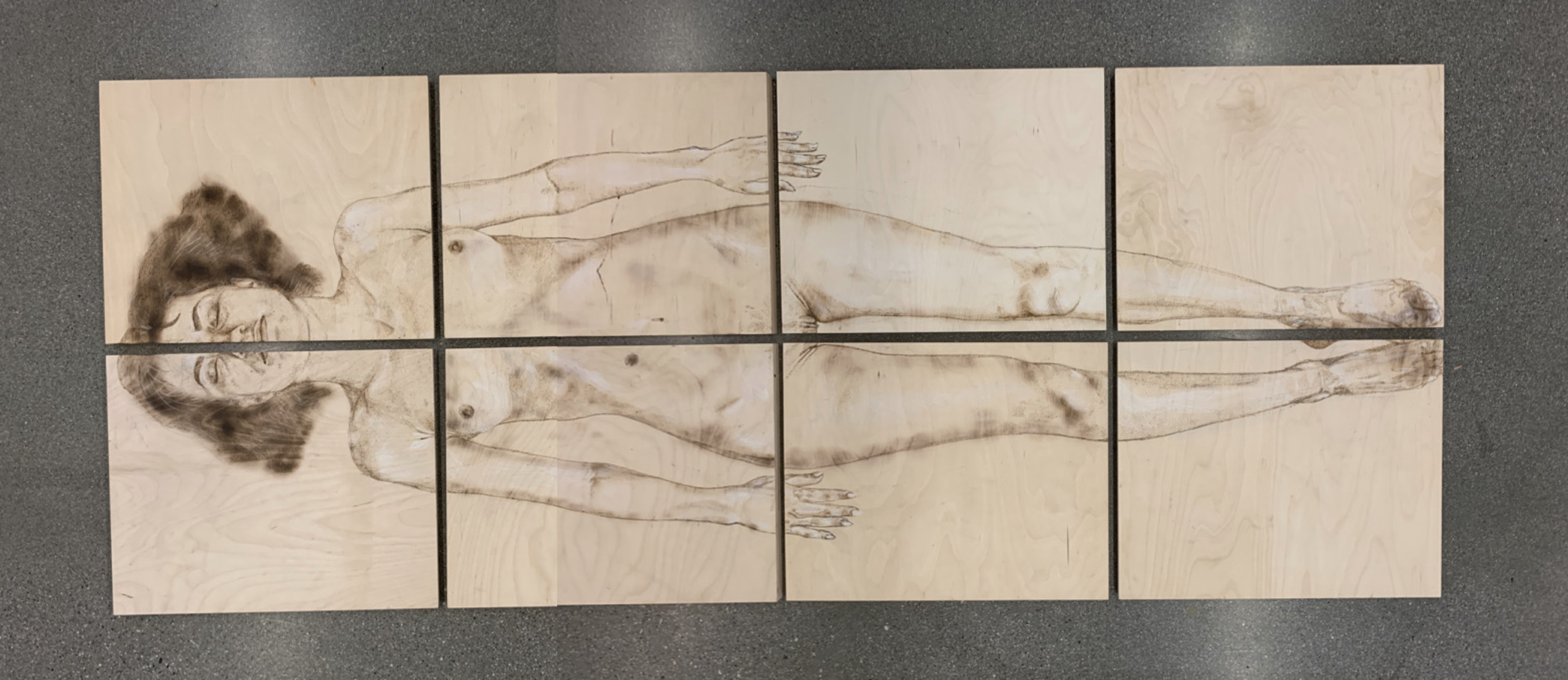What is an
image?
a picture of people taking pictures
google:
Enter the Dragon: On the Vernacular of Beauty by Dave Hickey
'If images don't do anything in this culture[.] If they haven't done anything, then why are we sitting here in the twilight of the twentieth century talking about them? And if they only do things after we have talked about them, then they aren't doing them, we are. Therefore, if our criticism aspires to anything beyond soft-science, the efficacy of images must be the cause of criticism, and not its consequence - the subject of criticism and not its object. And this', I concluded rather grandly, 'is why I direct your attention to the language of visual effect - to the rhetoric of how things look - to the iconography of desire - in a word, to beauty”
MY MOMMY IS BEAUTIFUL (2004-2021)
by Yoko Ono
My Mommy is Beautiful (2004/2021) by Yoko Ono is an ongoing interactive work in which the audience is encouraged to write on a paper what they think about their mother and then paste it to the communal wall. This installation at the Vancouver Art Gallery takes place in a room roughly 20 by 10ft. The floor is carpeted with small rectangles cut out and covered in glass featuring images of women. As you walk in, you see the center of the piece in the back right corner with a plaque reading "MY MOMMY IS BEAUTIFUL[,] Write about your mother on the wall paste her image write your feelings of your mother when you think of her." Countless papers pasted to the wall with small pencil writings surround the plaque and move outward to fill the room.


ideas of self-representation as a response:
This brings me to Mapping Women's Self-Representation at Visual/Textual Interfaces by Julia Watson and Sidonie Smith. Here, the idea of autobiography for women is discussed as an opportunity to reflect on the past, identity, and critique cultural and social norms. They also introduce the question of narcissism in self-representation; "two widely held suspicions about women's recourse to the autobiographical in visual and performance media need to be addressed—that it is a transparent mirroring and that it is narcissistic self-absorption (Watson)." However, as Watson and Smith argue, autobiography should be seen as an act of narration "situated in historical time and cultural place, deploy discourses of identity to organize acts of remembering that a directed to multiple addresses or readers (Watson)." Ono's presentation of the mother as something beautiful in the title could be seen as a narcissistic move knowing she is a mother herself. However, the beauty of this work comes in the versatility of its interpretations or emotional evocation. In fact, something I found interesting is that I was so happy seeing this artwork that I sent a photo of the installation to my mother. She had a very different response to it; she thought it was "sad" that motherhood could be reduced to something so simple.
My self representation:



Blinded insights by hal foster
- Most modernists saw the art of the mentally ill according to their own ends- as expessive of an aesthetic essence , revelatory of an innocent vision, or defiant of all convention.
- “rather, these three reasingds – call theem ‘expressionist’ ‘visionary’ and ‘trangressive’, respectively- bespeak modernist fantasies either of a pure origin of art or an absolute alterity to culture, and they obscure more than reveal the import od the art of the mentally ill.”
- Romantics also views art of the mentally ill as an epitome of creative genius. However the value of this art of downgraded by the late nineteenth century it was a symptom of degeneration, not a model of inspiratioin.
- Lombroso understood madness as a retyrn to a primitive stage fo development
- Freud only extended the diafgnostic approach through reversal, as he searched for sugns of psychi disturbance in the art of sane masters like Leonardo and
miuchelangelo.
- Bildnerei publication includes ten cases of schizoohrenic masters.
o Although several works show affinities with symbolist and expressionist art, few of the patients were teained or interested in art at all.
o Often compelled by visions to which they were subject
o Prinzhornaimsnottobediagnostic→“apurelypsychiatricapproachis
insufficient” and he doesn’t regard the works as direct symptoms of the
illness
o Although he proposes six drives as dominant psychotic representation
- His theory. Of six drives that govern all art- drives toward expressionism, play, ornamental elaboration, patterned order, obsessive copying, and symbolic systems- which again he deemed to be especially apparent in the art of the mentally ill.
- Paul Klee “art does not reproduce visible; rather, it makes it visible.”
- “’the child, the madman and the savage’ with special power,f o they ‘can still, or
again look into’ the ‘in-between worlld’ that ‘ eists between the worlds our sense perceive
Subjectivity as Encounter: Feminine Ethics in the Work of Bracha Lichtenberg Ettinger and Anne Enright by MARIELLE SMITH
- ettinger articulates a relationality between subjects that radically transforms the persisting dualism between "self' and "other."
- If the male child has to acknowledge the existence and importance of the womb, it would have to give up the belief that his sex is the one in possession of the one valu able organ or signifier, the phallus. S
- As 1 have pointed out, we need to see ourselves in a negative relation to others
within the symbolic order: I am who I am because of who I am not. How could we understand the self differently, when our entrance into this patriarchal framework—our becoming subject—is based on the solid image that we see in
the mirror? For Lacan, the necessary recognition of the self in this mirror is one of the subject's greatest trau mas, since there is always more to the "I" than the mirror can reflect. Although the child needs to understand itself as a unified totality, it, not being in control over its own body, "experiences itself in a schism, as a site of fragmentation" (Grosz 1990, 39). The image we learn to recognize in the mirror is thus always a misrecognition. This visual illusion leads us to believe that we are separate from others and that we can no longer connect to them in the same manner as we did before we entered that system. However, according to Ettinger, our entrance into society does not foreclose our ability to relate to
others in a feminine matrixial way. The language that we acquire during that process merely prevents us from seeing ourselves and others as anything but whole (Pollock 2009b, 9). S
- Since we are not coherent and solid, we are chasing after an image of ourselves that does not exist. According to Ettinger, the pain we experience due to our failed attempts at feeling whole will lead us to blame others, since it is our relationality to them that makes us feel incomplete and unsta
- As Ettinger's theory explains, we experience our own partiality as a threat to the nonexisting boundaries of our "I" because we are unable to articulate it it come
- Ettinger is not the first to take the issue of subjectivity to this level. Bersani, too, argues that the subject as proposed by Freudian psychoanalysis has led to "paranoia" being the "dominant social structure" in Western society (Bersani 1986, 47).
- This is not because our fragile boundaries, by definition, make us feel as though our identi ties are under threat. Contrary to the phallic perspective, "[i]n the matrix, the stranger, neither cut out from the system nor assimilated to it, cannot be articulated as a parasite and cannot be rejected" (Ettinger 2006, 111;
emphasis in original). Instead of being unable to share in the trauma and the fantasy of the other, there is, "in the matrix ... an impos' sibility of not sharing them" (90; emphasis in original). That matrixial encounter events make us feel "fragile and vulnerable" does not mean we have to try to protect ourselves against them (Pollock 2009a, 45). On the contrary, as Pollock proposes, "they may also solace something profound in us that undoes the absolute binary of pleasure/pain and forms the basis of our being able to share the suffering of another, or feel with another's trauma" (Pollock 2009b, 17). The shattering of our sense of self will not lead to the dissolution of the "I" because the experience is "not overwhelm ing but humanizing" (Pollock 2009a, 45).
- one of the aims of Ettinger's theory is to acknowledge and embrace the trauma of
what it means to be human. For Ettinger, one's subjectivity is based on a co- emerging and being with other subjects, an ethical implication that inevitably entails the experience of both pleasure and pain.
-

Self-portrait 2021
Pyrography on wood
eight 20 x 16 inches panels